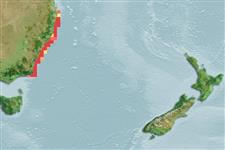Lớp phụ Cá sụn (cá mập và cá đuối) (sharks and rays) >
Rhinopristiformes (Shovelnose rays) >
Trygonorrhinidae (Banjo rays, Fiddler rays)
Etymology: Trygonorrhina: Greek, trygon = a sting ray + Greek, rhinos = nose (Ref. 45335).
More on authors: Müller & Henle.
Environment: milieu / climate zone / depth range / distribution range
Sinh thái học
Biển gần đáy; Mức độ sâu 0 - 100 m (Ref. 114953). Subtropical; 28°S - 38°S, 149°E - 155°E (Ref. 114953)
Southwest Pacific: endemic to eastern Australia.
Bộ gần gũi / Khối lượng (Trọng lượng) / Age
Maturity: Lm ? range ? - ? cm
Max length : 120 cm TL con đực/không giới tính; (Ref. 114953); Khối lượng cực đại được công bố: 6.7 kg (Ref. 6870)
This large shovelnose ray is distinguished by the following characters: suboval disc, short and broadly rounded snout with nostrils partly covered with a large nasal curtain; sharp thorns present on mid-line of disc and shoulders; behind interorbital space is an ornate pattern of dark-edged bands with distinct triangular or diamond-shaped marking (Ref. 114953).
A benthic species and an active scavenger which will enter fish traps and often becoming ensnared by the disc (Ref. 6871). Found also on sandy bottoms and seagrass areas, often near rocky reefs (Ref. 12951). Mainly feeds on crabs and shrimps (Ref. 114953). Ovoviviparous with golden egg capsules, each with up to 3 embryos (Ref. 12951). Produces up to 2-3 pups. Length size seldom exceeds 110 cm TL; birth size at ca. 25 cm TL (Ref. 114953). The flesh is good to eat, although only a small quantity is sold in seafood outlets (Ref. 6871).
Life cycle and mating behavior
Chín muồi sinh dục | Sự tái sinh sản | Đẻ trứng | Các trứng | Sự sinh sản | Ấu trùng
Exhibit ovoviparity (aplacental viviparity), with embryos feeding initially on yolk, then receiving additional nourishment from the mother by indirect absorption of uterine fluid enriched with mucus, fat or protein through specialised structures (Ref. 50449).
Last, P.R., W.T. White, M.R. de Carvalho, B. Séret, M.F.W. Stehmann and G.J.P. Naylor, 2016. Rays of the world. CSIRO Publishing, Comstock Publishing Associates. i-ix + 1-790. (Ref. 114953)
IUCN Red List Status (Ref. 130435)
Threat to humans
Harmless
Human uses
Các nghề cá: buôn bán nhỏ; cá để chơi: đúng; Bể nuôi cá: Bể cá công cộng
Thêm thông tin
Các tài liệu tham khảoNuôi trồng thủy sảnTổng quan nuôi trồng thủy sảnCác giốngDi truyềnElectrophoresesDi sảnCác bệnhChế biếnNutrientsMass conversion
Các công cụ
Special reports
Download XML
Các nguồn internet
Estimates based on models
Preferred temperature (Ref.
123201): 17.3 - 22.5, mean 20.7 °C (based on 18 cells).
Phylogenetic diversity index (Ref.
82804): PD
50 = 0.6250 [Uniqueness, from 0.5 = low to 2.0 = high].
Bayesian length-weight: a=0.00724 (0.00267 - 0.01964), b=3.00 (2.76 - 3.24), in cm total length, based on LWR estimates for this (Sub)family-body shape (Ref.
93245).
Mức dinh dưỡng (Ref.
69278): 3.7 ±0.6 se; based on size and trophs of closest relatives
Thích nghi nhanh (Ref.
120179): thấp, thời gian nhân đôi của chủng quần tối thiểu là 4.5 - 14 năm (Fec assumed to be <100).
Fishing Vulnerability (Ref.
59153): High to very high vulnerability (72 of 100).
Nutrients (Ref.
124155): Calcium = 21.8 [4.2, 100.2] mg/100g; Iron = 0.68 [0.18, 1.97] mg/100g; Protein = 19.3 [17.2, 21.2] %; Omega3 = 0.211 [0.096, 0.452] g/100g; Selenium = 25.1 [7.4, 71.4] μg/100g; VitaminA = 7.73 [2.65, 21.92] μg/100g; Zinc = 0.561 [0.278, 1.008] mg/100g (wet weight);
